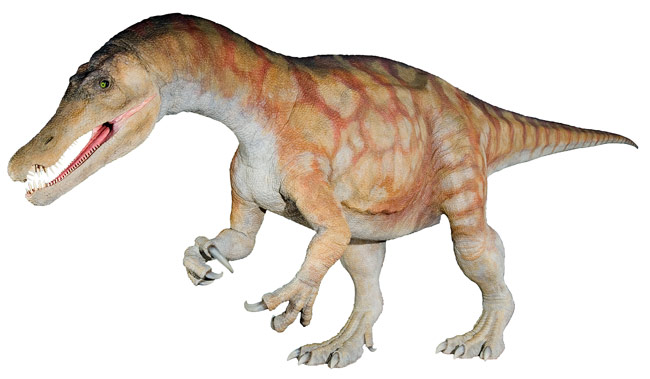Something Fishy About This Dinosaur Discovery

An unusual carnivorous dinosaur whose skull looked part-crocodile may have fancied fish over other meat, research now reveals.
These findings suggest the predator's huge fearsome 12-inch-long hand claws might have actually been used as grappling hooks to scoop fish from the water, somewhat like a grizzly bear.
The dinosaur in question, Baryonyx walkeri, was discovered in clay pits in England in 1983 by an amateur collector, William Walker, and named after him by researchers. The 30-foot-long predator stalked the Earth on two legs during the early Cretaceous, roughly 125 million years ago.
Unlike other theropods such as Tyrannosaurus rex, Baryonyx did not possess blade-like serrated teeth. Instead, Baryonyx's long narrow jaws had small pointed teeth, much like in alligators and crocodiles. It also had a bulbous tip at the end of its snout that held a clump of teeth, a trait seen today in slender-jawed fish-eating crocodilians such as the Indian gharial.
In other words, Baryonyx's skull "looked part-dinosaur and part-crocodile, so we wanted to establish which it was more similar to, structurally and functionally – a dinosaur or a crocodile," said researcher Emily Rayfield, a paleontologist at the University of Bristol in England.
The researchers scanned the skull of Baryonyx with X-rays to generate a digital model of it. Rayfield and her colleagues then compared the digital model of Baryonyx's snout with those of an alligator, a gharial and a typical theropod.
Computer models now reveal that while Baryonyx was eating, its skull bent and stretched in the same way as that of the gharial. "We've got a dinosaur whose skull has independently become very much like a crocodilian in certain aspects, and now we find they're similar in how they actually feed as well," Rayfield said.
Get the world’s most fascinating discoveries delivered straight to your inbox.
The skulls of both the gharial and Baryonyx seem optimized to resist bending, while the alligator's is most effective at resisting twisting. The generic theropod skull was more all-purpose, "which fits in with what we know of its feeding behavior, where its head had to move in lots of different directions to catch small moving prey," Rayfield told LiveScience.
The scientists have found partially digested fish scales and teeth around the stomach of a fossil Baryonyx, but also discovered a bone from a juvenile Iguanodon there as well. So while Baryonyx may have fed predominantly on fish, it occasionally dined on other prey as well.
Rayfield and her colleagues are also investigating a relative of Baryonyx known as Spinosaurus, which had a more robust skull. "A Spinosaurus tooth has been found embedded in the backbone of a pterosaur," Rayfield said. "My feeling is that Spinosaurus' skull was a little bit stronger than Baryonyx, and probably fed on a broader breadth of animals."
The scientists detailed their findings in the latest issue of the Journal of Vertebrate Paleontology.



